Red River Blu-ray Movie
HomeRed River Blu-ray Movie 
Theatrical and Prerelease versions / Blu-ray + DVDCriterion | 1948 | 1 Movie, 2 Cuts | 133 min | Not rated | May 27, 2014
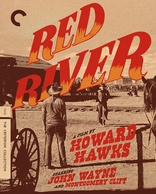
Movie rating
8 | / 10 |
Blu-ray rating
| Users | 4.5 | |
| Reviewer | 5.0 | |
| Overall | 4.7 |
Overview
Red River (1948)
A young cowhand rebels against his rancher stepfather during a perilous cattle drive.
Starring: John Wayne, Montgomery Clift, Joanne Dru, Walter Brennan, Coleen GrayNarrator: Walter Brennan
Director: Howard Hawks, Arthur Rosson
| Western | Uncertain |
| Romance | Uncertain |
| Adventure | Uncertain |
| Action | Uncertain |
Specifications
Video
Video codec: MPEG-4 AVC
Video resolution: 1080p
Aspect ratio: 1.37:1
Original aspect ratio: 1.37:1
Audio
English: LPCM Mono (48kHz, 24-bit)
Subtitles
English SDH
Discs
50GB Blu-ray Disc
Four-disc set (2 BDs, 2 DVDs)
DVD copy
Playback
Region A (locked)
Review
Rating summary
| Movie | 5.0 | |
| Video | 4.0 | |
| Audio | 4.5 | |
| Extras | 5.0 | |
| Overall | 5.0 |
Red River Blu-ray Movie Review
Reviewed by Dr. Svet Atanasov May 9, 2014Howard Hawks' "Red River" (1948) arrives on Blu-ray courtesy Criterion. The supplemental features on the disc include an original trailer for the film; new video interview with filmmaker and critic Peter Bogdanovich; clips from an archival interview with the legendary American director; new video interview with critic Molly Haskell; clips from an archival interview with novelist and screenwriter Borden Chase; Lux Radio Theatre adaptation of Red River featuring John Wayne, Walter Brennan, and Joanne Dru; and more. The release also arrives with an illustrated booklet featuring an essay by critic Geoffrey O'Brien and a 1991 interview with Howard Hawks' longtime editor Christian Nyby, as well as a new paperback edition of Borden Chase's original novel, previously out of print. In English, with optional English SDH subtitles for the main feature. Region-A "locked".
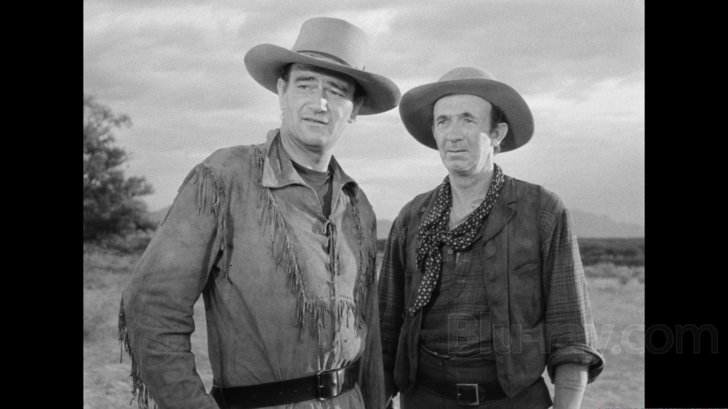
"He'll do..."
After the Civil War. John Wayne is Tom Dunson, a free man who leaves behind the woman he loves and heads to Texas together with his right-hand man Groot Nadine (Walter Brennan, To Have and Have Not , My Darling Clementine) to build the cattle ranch he has been dreaming about. Somewhere near the Red River, Dunson and Nadine meet Matt Garth (Mickey Kuhn/Montgomery Clift), a bright boy who has miraculously survived an Indian attack. Dunson offers Garth to stay with them and help them build the ranch.
Fourteen years later. Dunson has become the biggest cattle baron in the West, but desperately needs money to continue operating his ranch. To raise the money, Dunson decides to take 9,000 head of cattle to Missouri, where the market is booming. He hires a group of cowboys to assist and protect him and then heads up North.
In the beginning the men are convinced that they will reach Missouri and get paid for their work, but a giant stampede followed by terrible weather and starvation forces many of them to question Dunson’s leadership. Eventually Dunson tries to punish two deserters, but Garth sides with the men and then promises to lead them to Abilene, where the railroad tracks are, so that they can reach Missouri faster. Barely able to contain his anger, Dunson vows to kill Garth next time they meet.
On the way to Missouri, Garth and his men witness an Indian attack on a wagon train heading West. After they drive away the Indians, Garth spends time with the beautiful and single Tess Millay (Joanne Dru, She Wore a Yellow Ribbon, Thunder Bay), who immediately falls in love with him. They part ways shortly before Dunson and a gang of mercenaries appear looking for Garth’s wagon train.
An indisputable American classic, Howard Hawks’ Red River is a film of immense beauty. The visuals, especially during the second act, where Dunson and his men begin their journey, are indeed impossible to describe with simple words.
The epic atmosphere never leaves the film. Even the intimate scenes, such as the one where Garth and Millay warm up to each other, are shot with tremendous sense of style. In the overwhelming majority of the westerns from the same era the focus of attention is typically on the panoramic visuals, but in Red River the quiet moments are just as carefully observed by the camera.
Based on Borden Chase’s story "The Saturday Evening Post", Red River was Clift’s debut film (though it was The Search that introduced the young actor to American audiences because Red River’s release was delayed due to legal issues). In 1949, the film earner two Oscar nominations, one for Best Writing (Chase), and another for Best Film Editing (Christian Nyby).
There are two different versions of Red River that have been shown theatrically. The shorter version, which runs at approximately 127 minutes, was apparently the preferred by director Hawks version of his film. The longer version, also known as the Prerelease Version, which was also the one MGM initially released on DVD in North America, runs at approximately 133 minutes. This longer version of the film is the one that is included on Eureka Entertainment’s upcoming Blu-ray release.
Red River Blu-ray Movie, Video Quality 
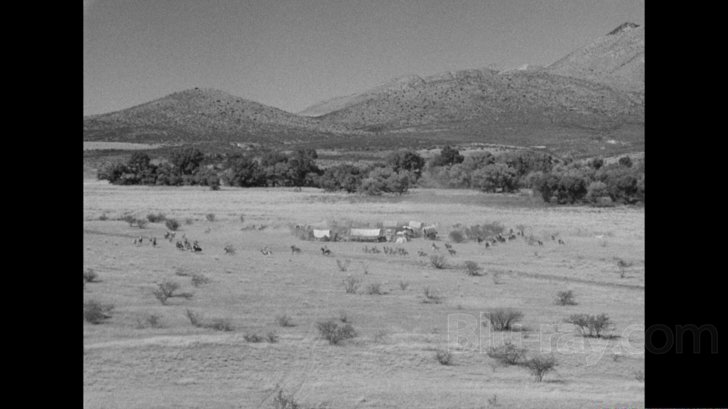
Presented in its original aspect ratio of 1.37:1, encoded with MPEG-4 AVC and granted a 1080p transfer, Howard Hawks' Red River arrives on
Blu-ray courtesy of Criterion.
The following text appears inside the booklet provided with this Blu-ray release:
"Because of the film's complicated postproduction schedule and logistics -- as partially detailed on page 16, in the interview with editor Christian Nyby -
- film elements for the director's preferred version of the film, the final 127-minute theatrical release from 1948, proved rarer than those for the now
more common 133-minute prerelease version, a cut of the film assembled sometime before its official premiere. This new digital transfer of the
prerelease version of Red River was created in 2K resolution on a Scanity film scanner from a 35mm duplicate negative. To reconstruct the
theatrical cut, we used a 35mm print from MGM's archives as a visual reference; this was not viable as a master source, however, because of film
frame damage. With that print as a guide, we assembled the majority of the theatrical version from the 2K scans made for the prerelease cut. There
are a number of sections in the theatrical version, though, that do not exist in the prerelease one, such as the different optical sequences that
accompany the voice-over narration. After much searching, a French 35mm composite print was located at Cinematheque francaise. Digital transfers of
remaining sections of the theatrical version were created in 2K resolution on a Scanity film scanner from the preserved print. Thousands of instances of
debris, splices, and warps were manually removed using MTI's DRS, while Digital Vision's Phoenix was used for small flicker, scratches, and grain
management and Pixel Farm's PFClean for jitter. Because of the difficulty of acquiring complete source material for the opening and closing credits of
the theatrical version, which differ from those of the prerelease one, we used a standard-definition PAL DigiBeta provided by MGM for those two
segments. The original film used for that transfer could not be located.
Assembling the soundtrack for the theatrical version presented similar problems. For the prerelease version, the original monaural soundtrack was
remastered at 24-bit from a 35mm optical soundtrack. This was then used as the primary source for the reconstruction of the theatrical soundtrack.
While the two versions diverged -- for example, in the theatrical version's inclusion of voice-over and somewhat different music my Dimitri Tiomkin --
an alternate 35mm optical element was used. Whenever possible, minute audio dropouts in the theatrical soundtrack were corrected through careful
mixing with isolated prerelease sections. Clicks, thumps, hiss, and hum were manually removed using Pro Tools HD. Crackle was attenuated using
AudioCube's integrated workstation.
Transfer supervisors: Lee Kline, Russell Smith.
Colorist: Lee Kline.
Theatrical version reconstruction: Gabriel Chavez.
Scanning: Colorworks, Culver City, CA.
Scanning and film preparation: Alex Hernandez/Colorworks, Culver City, CA."
Please note that the screencaptures included with this review appear in the following order:
1. Screencaptures #1-19 are from the Theatrical Version (Disc One).
2. Screencaptures #21-36 are from the Prerelease Version/Longer Version (Disc Two).
The basic characteristics of the shorter and longer versions of the film are fairly similar to those of the longer version which Eureka Entertainment released on Blu-ray last year. Indeed, image depth, detail,
and clarity are just as pleasing. However, there are minor discrepancies between the contrast and brightness settings -- there are select areas of the
film where Criterion's transfers look slightly brighter (compare screencapture #21 with screencapture #7 from our review of the Eureka Entertainment
release), while contrast is slightly elevated on the Eureka Entertainment transfer. Furthermore, there is extra digital work done on Criterion's transfers
and as a result the film has a better balanced look. To be perfectly clear, many debris scratches, flecks, and tiny vertical lines that are visible on the
Region-B release have been carefully removed (compare screencapture #19 with screencapture #15 from our review of the Region-B release). This
being said, I would like to make it perfectly clear that the same minor image fluctuations -- which can be traced back to the existing elements -- are
present on both releases (longer version). In other words, there are portions of the film where minor sharpness and clarity fluctuations can be seen,
but they are not a byproduct of poor digital corrections. Grain has been retained and it is very easy to see throughout the entire film, though because
of age-related issues, such as natural deterioration and fading, it isn't always evenly distributed. Edge-enhancement is not an issue of concern. Lastly,
the compression and encoding here are better and this becomes clear during select daylight sequences, but I doubt most viewers would be able to tell.
(Note: This is a Region-A "locked" Blu-ray release. Therefore, you must have a native Region-A or Region-Free PS3 or SA in order to access its
content).
Red River Blu-ray Movie, Audio Quality 
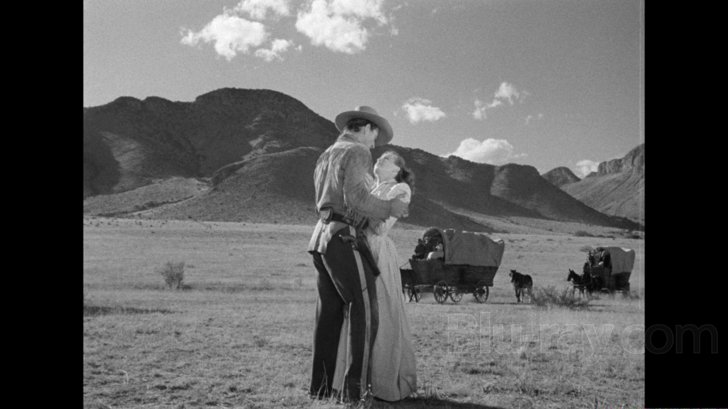
The two versions of Red River come with LPCM 1.0 tracks. For the record, Criterion have provided optional English SDH subtitles for each
version.
Depth and clarity are very pleasing. Minor fluctuations exist, but there are no sudden spikes or drops in dynamic activity. The dialog is stable and easy
to follow. Also, it appears that some additional work has been done to attenuate background hiss on the two versions of the film. Crackle, pops, and
clicks have also been removed as best as possible. There are no problematic high-frequency distortions.
Red River Blu-ray Movie, Special Features and Extras 
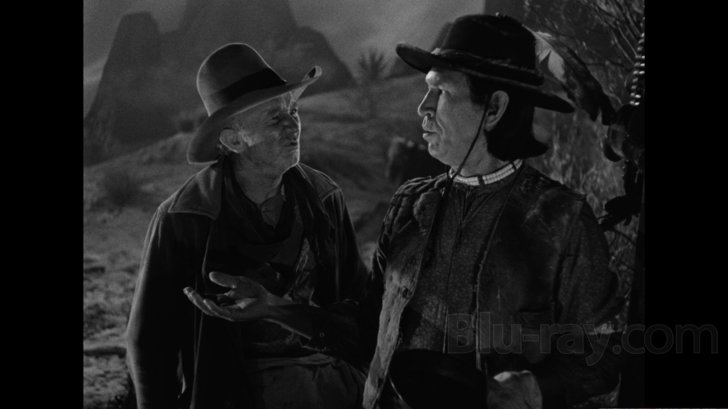
DISC ONE
- About the Versions - the following text-format description is included on the disc: "There are two versions of Red River presented on this release: the 1948 theatrical version, which director Howard Hawks preferred, and a longer, prerelease cut of the film. Although there are a number of differences -- for example, the earlier version contains extra shots and dialogue, and has a prologue scroll -- two things in particular set them apart tonally. First, the theatrical version substitutes voice-over narration by Walter Brennan for the prerelease cut's optical sequences of book pages. Second, the ending of the theatrical release is significantly shorter."
- Trailer - original MGM trailer for Red River. In English, not subtitled. (2 min, 1080i).
- Bogdanovich on Red River - in this new video interview, filmmaker and critic Peter Bogdanovich recalls his interactions with Howard Hawks, and discusses the two versions of Red River, Howard Hughes' demands after the film was completed, John Wayne and Montgomery Clift's performances, Howard Hawks' directing methods, etc. The interview was conducted exclusively for Criterion in 2014. In English, not subtitled. (17 min, 1080p).
- Hawks and Bogdanovich - presented here are audio excerpts from an interview Peter Bogdanovich conducted with Howard
Hawks in Palm Springs, California in 1972. The legendary American director discusses the filming of Red River. In English, not subtitled. (16
min).
1. Script and locations
2. River Crossing
3. Montgomery Clift
4. John Ireland
5. The ending
6. Black and white
7. Two versions
- Lux Radio Theatre - a Lux Radio Theatre adaptation of Red River featuring John Wayne, Walter Brennan,
and Joanne Dru. It was broadcast on March 7, 1949. In English, not subtitled. (59 min).
1. Introduction
2. Act I: Red River D
3. Intermission
4. Act II: Driving north
5. Special guest
6. Act III: Garth in charge
7. Curtain call
- Molly Haskell - in this new video interview, critic Molly Haskell discusses Howard Hawks' unique body of work, the interactions between the two sexes in his films and specifically in Red River, the balance between comedy and drama in the film, the unique framing in select sequences, etc. The interview was conducted exclusively for Criterion in 2014. In English, not subtitled. (16 min, 1080p).
- Lee Clark Mitchell - in this new video interview, Lee Clark Mitchell, author of Westerns: Making the Man in Fiction and Film, discusses some of the key themes and conflicts in the western genre, the great novel by Borden Chase that inspired Howard Hawks to shoot Red River, some of the similarities and differences between the novel and the film, the unique bond between John Wayne and Montgomery Clift's characters, etc. The interview was conduced exclusively for Criterion in 2014. In English, not subtitled. (14 min, 1080p).
- Borden Chase - presented here are four excerpts from an audio interview with novelist and screenwriter Borden Chase
conducted by western scholar Jim Kitses, author of Horizons West, in 1969. Borden Chase recalls his initial encounter with Howard Hawks,
Howard Hughes' cutting of Red River, etc. In English, not subtitled. (11 min).
1. Inspiration
2. "I don't collaborate"
3. Howard Hughes"
4. Staying cynical"
- Booklet - an illustrated booklet featuring an essay by critic Geoffrey O'Brien and a 1991 interview with Howard Hawks' longtime editor Christian Nyby; a new paperback edition of Borden Chase's original novel, previously out of print.
Red River Blu-ray Movie, Overall Score and Recommendation 
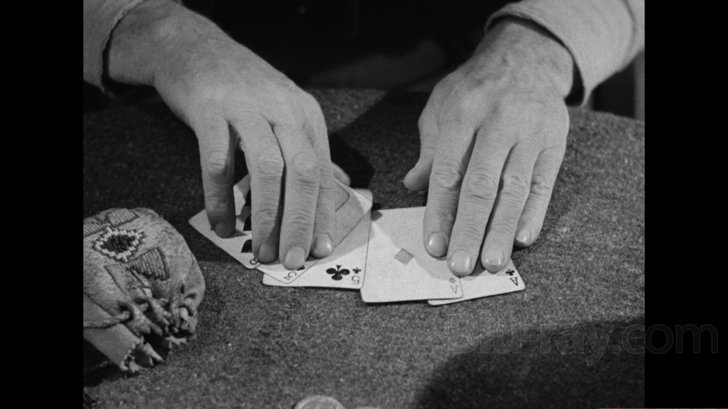
There is nothing that I can say about Red River that hasn't already been said before. It is a timeless American masterpiece which will be revisited and rediscovered for as long as there are people who appreciate great films. Criterion's upcoming Blu-ray release of Red River will likely remain the film's definitive home video release. It features two versions of the film: the shorter and preferred by director Howard Hawks version and the longer prerelease version. In addition to a great selection of supplemental features, including a terrific new video interview with filmmaker and critic Peter Bogdanovich, Criterion have included with the Blu-ray release a new paperback edition of Borden Chase's original novel. VERY HIGHLY RECOMMENDED.
Other editions
Red River: Other Editions
Similar titles
Similar titles you might also like

The General
1926

Shanghai Express
1932

How the West Was Won
1962

Fort Apache
1948

Stagecoach
1939

Santa Fe
1951

The Treasure of the Sierra Madre
1948

Duel in the Sun
Roadshow Edition
1946

The Wild Bunch
1969

The Iron Horse
Limited Edition to 3000
1924

Forty Guns
1957

Great Day in the Morning
Warner Archive Collection
1956

The Searchers 4K
Warner Archive Collection
1956

Winchester '73
1950

One-Eyed Jacks
1961

My Darling Clementine
Theatrical and Prerelease Versions
1946

River of No Return
1954

The Outlaw Josey Wales 4K
1976

Guns of the Magnificent Seven
1969

Man of the West
1958

